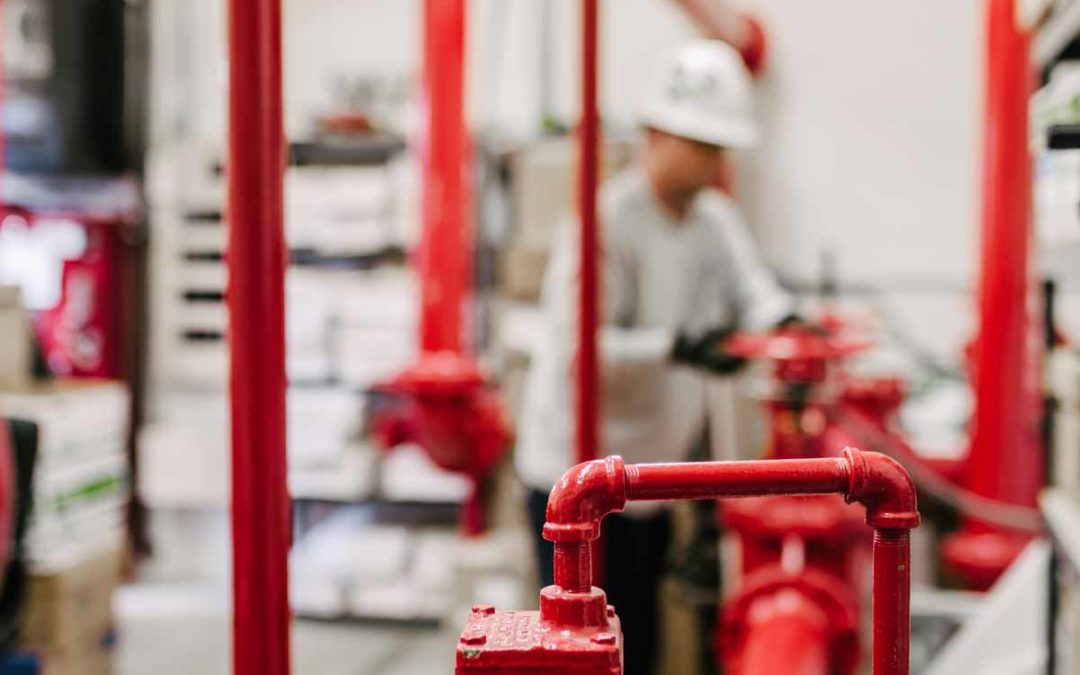Let’s look at the importance of fire protection in oil and gas process facilities and the four components that make up this essential system.
The Importance of Fire Protection Systems in Oil & Gas Process Facilities
Due to the nature of the work, oil and gas process facilities are surrounded by fire risks. Highly flammable liquids and gases can lead to intense fires which can be difficult to manage — threatening property damage, pollution, and risk to human life.
The American Petroleum Institute (API) and the National Fire Protection Association (NFPA) developed fire codes specifically for petrochemical facilities designed to minimize risks and ensure that the facility is protected against damage in case of a fire. The API offers a number of resources that identify the fire safety hazards associated with oil & gas process facilities, and provide solutions for protection and prevention.
Let’s take a brief look at a few of the biggest fire hazards facing petrochemical facilities.
Biggest Fire Risks in Oil & Gas Process Facilities
The biggest risks occur when oil escapes from its containment where a stray spark can ignite and start a dangerous fire. Here are six of the most common petrochemical fire and explosion hazards that can occur at an oil process facility:
- BLEVE (boiling liquid expanding vapor explosion): Occurs when the contents are above boiling point and the container fails.
- Explosions: One of the most dangerous scenarios in any petrochemical facility, explosions are caused by the ignition of a flammable vapor within a confined space.
- Flammable liquid pool fires: Result from the loss of product containment in any kind of storage tank, paired with a common ignition source, like nearby electrical equipment. Combustible or flammable liquid storage tank fires are also a type of large pool fires.
- Flash fires: The ignition of flammable vapors in an unconfined area which most often happens during normal transfer operations of flammable liquid tanks, spills, or leaks from flammable liquid vessels.
- Jet fire: Ignited liquid or gas that escapes under pressure from a process vessel or pipe.
- Normal combustible fire: Class A fires are equally as plausible as flammable liquid fires in any oil and gas facility, and should be considered, especially in any offices or outbuildings.
To protect the facility and personnel from fire, petrochemical fire protection systems must be designed to address the specific fire risks of the industry.
Four Components of Fire Protection Systems in Oil & Gas Process Facilities
Four main components of the robust fire protection system are: water and foam fire suppression systems, fire extinguishers, fire alarms, and fire safety training.
#1 Fire Suppression Systems
Foam fire suppression is especially desirable in petrochemical fire protection systems. When the system’s sensors detect a fire, they smother flammable liquid with a viscous, bubbly liquid that extinguishes any active flames while also preventing other areas from catching fire.
Water mist systems are also effective in oil and gas process facilities because they spray fine water droplets (less than 1,000 microns across). The mist minimizes water damage while still extinguishing the fire.
Large Dry Chemical systems are an effective means to extinguish flammable liquid fires especially where water supplies are not readily accessible.
#2 Fire Extinguishers
Oil process facilities should primarily use BC fire extinguishers, as they are appropriate for the classes of fire the industry is prone to. This type of extinguisher is adept at handling fires of ordinary combustibles, electrical equipment and wiring, and flammable liquids and gases. Make sure all employees know where fire extinguishers are located and how to use them.
#3 Fire Alarm Systems
Oil & gas process facilities are required to include a fire alarm system that includes heat, flame, and gas detectors for automatic activation, pull stations for manual activation, and strobe lights and sirens to alert personnel of danger. Fire alarms must be regularly inspected to make sure they comply with NFPA and API code and can effectively function in any conditions.
#4 Fire Safety Training
Even with the best technology in fire prevention and suppression, nothing can replace fire safety training. A safety-first approach to fire preparedness in petrochemical facilities comes down to the training of personnel who will use fire extinguishing tools and respond appropriately to a fire threat, notifying authorities quickly.
A few ways to prioritize personnel training include:
- Specific hazards at your facility and a detailed explanation on how the fire protection system works to prevent and extinguish fires.
- How to use fire-fighting equipment including fire extinguishers, fire alarms, sprinkler systems, and any other technology utilized by your facility.
- Your facility’s evacuation plan. Run regular but varied drills to practice evacuation routes and response times.
Additional training to consider is first aid, so employees can assist fellow workers if an emergency arises, evacuating people from danger and addressing minor injuries.
Oil & Gas Fire Protection System Maintenance
Finally, the fire protection system used in oil and gas process facilities is only effective if it is well-maintained. Regular inspections and maintenance are not only required by fire codes, but ensure that the equipment remains in optimal condition, which will save companies money on repairs or replacement down the road.
The best way to keep up with maintenance is to commit to a regular service schedule. Keep in mind that different types of equipment may need to be checked more frequently. Work with fire safety professionals who are familiar with the fire risks of oil and gas process facilities to ensure that your fire protection system is working as it should.
Petrochemical facilities require the highest-quality fire protection systems, paired with top-of-the-line testing and maintenance. An industry leader in oil and gas fire protection, Vanguard Fire & Security Systems has the experience and expertise you need.


